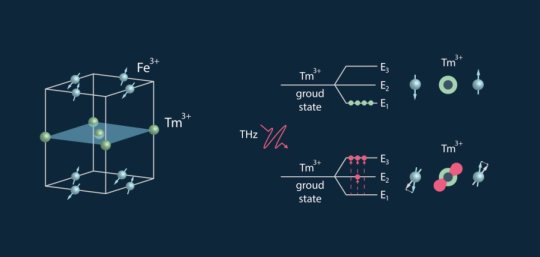
Scientists
have found a way to significantly improve computer performance. They propose
the use of the so-called T-waves, or terahertz radiation as a means of
resetting computer memory cells. This process is several thousand times faster
than magnetic-field-induced switching.
Together with their colleagues from Germany and the Netherlands, scientists at the Moscow Institute of Physics and Technology (MIPT) have found a way to significantly improve computer performance. In their paper published in Nature Photonics, they propose the use of the so-called T-waves, or terahertz radiation as a means of resetting computer memory cells. This process is several thousand times faster than magnetic-field-induced switching.
"We have demonstrated an entirely new way of controlling magnetization, which relies on short electromagnetic pulses at terahertz frequencies. This is an important step towards terahertz electronics. As far as we know, our study is the first to make use of this mechanism to trigger the oscillations of magnetic subsystems," says Anatoly Zvezdin of Prokhorov General Physics Institute and MIPT, a coauthor of the paper and a USSR State Prize-winning scientist heading MIPT's Laboratory of Physics of Magnetic Heterostructures and Spintronics for Energy-Saving Information Technologies.
The rapidly increasing amounts of digital data that have to be manipulated, along with the growing complexity of the computation tasks at hand, compel hardware designers to achieve ever higher computational speeds. Many experts believe that classical computation is currently approaching a limit, beyond which no further increase in data processing speed will be practicable. This is motivating scientists all over the world to investigate possibilities of entirely different computer technologies. One of the weak spots in modern computers holding back their evolution is memory: it takes time to complete every set/reset operation for a magnetic memory cell, and reducing the duration of this cycle is a very challenging task.
A group of scientists including Sebastian Baierl of the University of Regensburg, Anatoly Zvezdin, and Alexey Kimel of Radboud University Nijmegen (the Netherlands) and Moscow Technological University (MIREA) proposed that electromagnetic pulses at terahertz frequencies (with wavelengths of about 0.1 millimeters, i.e., between those of microwaves and infrared light) could be used in memory switching instead of external magnetic fields. A more familiar device that makes use of terahertz radiation is the airport body scanner. T-rays can expose weapons or explosives concealed under a person's clothing, without causing any harm to live tissues.
To find out whether T-rays could be used for convenient memory states switching (storing "magnetic bits" of information), the researchers performed an experiment with thulium orthoferrite (TmFeO?). As a weak ferromagnet, it generates a magnetic field by virtue of the ordered alignment of the magnetic moments, or spins of atoms in the microcrystals (magnetic domains). In order to induce a reorientation of spins, an external magnetic field is necessary.
However, the experiment has shown that it is also possible to control magnetization directly by using terahertz radiation, which excites electronic transitions in thulium ions and alters the magnetic properties of both iron and thulium ions. Furthermore, the effect of T-rays proved to be almost ten times greater than that of the external magnetic field. In other words, the researchers have devised a fast and highly efficient remagnetization technique -- a solid foundation for developing ultrafast memory.
The scientists expect their "T-ray switching" to work with other materials as well. Thulium orthoferrite, which was used in the experiment, happens to be convenient for the purposes of demonstration, but the proposed magnetization control scheme itself is applicable to many other magnetic materials.
"There was a Soviet research group that used orthoferrites in their studies, so this was always kind of a priority field for us. This research can be seen as a follow-up on their studies," says Anatoly Zvezdin.

 Previous page
Previous page Back to top
Back to top







